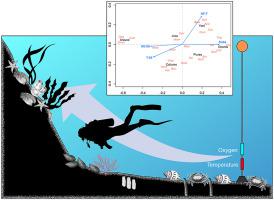Estuarine, Coastal and Shelf Science ( IF 2.6 ) Pub Date : 2021-01-11 , DOI: 10.1016/j.ecss.2021.107166 Aldo Hernández , Fabián J. Tapia

|
While spatial patterns in the structure of intertidal communities have been linked to changes in surface-ocean conditions indicative of coastal advection, nutrient supply, and productivity, less is known as to environmental features that, in addition to substrate type, are most influential in structuring subtidal benthic communities. Here we analyze data from subtidal benthic surveys conducted at six sites spanning ca. 180 km of shoreline along the upwelling coast of central Chile. Using continuous records of temperature and dissolved oxygen in bottom waters from each site, we tested whether among-site differences in community structure can be better explained by considering features of local environmental variability in addition to changes in substrate type. Starting from the NMDS ordination of benthic sites based on the presence and relative abundance of 29 species, we used PERMANOVA to test the explanatory power of substrate type and nine indices of environmental variability derived from in situ records. Three indices, namely the high-frequency variability and 95th percentile of bottom temperatures together with an index for the duration of hypoxia events, explained individually as much of the total variance as substrate type alone (ca. 30%). When combined into a single PERMANOVA analysis, these four factors explained 84% of the total variance in the NMDS-based ordination of benthic communities across the study region. A comparison of the benthic species ordination and environment-based site ordination suggests that soft-bottom species such as the razor clam Ensis macha, the snail Chorus giganteus, and the crab Cancer setosus, might be physiologically more tolerant to more rigorous conditions in terms of more intense warming and longer hypoxia events. Hard bottom species such as the gastropods Concholepas concholepas and Fissurella sp. and the barnacle Austromegabalanus psittacus thrive in environments where the temperature is lower on average but highly variable and where hypoxic conditions are intense but more intermittent. Our findings highlight the structuring role of the variability and the occurrence of extreme conditions, rather than the most frequent levels, in bottom-water properties such as temperature and dissolved oxygen. These two properties are closely intertwined in this and other coastal upwelling regions and are susceptible to change widely under future climate scenarios.
中文翻译:

潮下底栖生物群落的空间结构与上升温度沿岸的底部温度和溶解氧的时间变化的联系
尽管潮间带群落结构的空间格局与表层海洋状况的变化有关,表明沿海平流,养分供应和生产力,但人们对环境特征的了解却很少,除了底物类型外,对结构的影响最大。潮下底栖生物群落。在这里,我们分析了在大约6个地点进行的潮下底调查的数据。智利中部上升海岸沿岸180公里。我们使用连续记录每个站点底部水的温度和溶解氧的方法,测试了除了考虑基质类型的变化外,是否还可以通过考虑局部环境变化特征来更好地解释社区结构中站点间的差异。原位记录。三个指标,即高频变异性和底部温度的第95个百分位数,以及缺氧事件持续时间的指标,分别解释了总差异与单独的基质类型一样大(约30%)。当结合到单个PERMANOVA分析中时,这四个因素解释了整个研究区域基于底栖生物的NMDS排序的总方差的84%。对底栖动物排序和基于环境的地点排序的比较表明,软底物种,例如剃刀蛤ma恩西斯玛查(Ensis macha),蜗牛合唱团(Chorus giganteus)和螃蟹巨蟹座(setosus)就更剧烈的变暖和更长的缺氧事件而言,在生理上可能更耐受更严格的条件。硬底物种,如腹足纲的Concholepas conholepas和Fissurella sp。和藤壶Austromegabalanus psittacus在平均温度较低但变化较大的环境中生长良好,而缺氧条件强烈但间歇性较高的环境中。我们的发现强调了在底水属性(例如温度和溶解氧)中,可变性和极端条件(而不是最频繁出现)的发生的结构作用。这两个属性在该沿海地区和其他沿海上升地区紧密交织在一起,并且在未来的气候情景下很容易发生广泛变化。











































 京公网安备 11010802027423号
京公网安备 11010802027423号